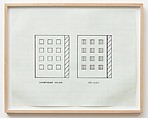Apartment House / Prison
Peter Halley American
Not on view
In his late twenties, Halley, a central figure in the New York art scene of the 1980s as well as an accomplished critic, theorist, and writer, began to produce signature paintings that take their severe motifs from the architecture of prisons, cells, or underground conduits. Often made with Roll-A-Tex, a grainy additive used to apply texture to walls and ceilings, and in unadulterated Day-Glo colors, Halley’s paintings provide a powerful counterpoint to the work of Minimalist artists such as Donald Judd. Much of the work produced by Judd and his contemporaries seemed for Halley and other artists in New York of the 1980s to rely too heavily on the phenomenological, experiential participation of the viewer. Through Halley’s reading of poststructuralist theory by figures such as Jean Baudrillard and Michel Foucault, the artist aimed to critique what he saw as the exaggerated claims of Minimalist sculpture by producing work within a tightly organized system of discrete, geometric motifs. This drawing is one of the first in the artist’s oeuvre to begin to describe this representational system. Here, Halley seems to draw a comparison between the boxy architecture of a modernist, high-rise apartment building and the form that a prison might take. On a more theoretical level, he evokes the idea that modernist architecture, or even modernism itself, might be prison-like. Indeed, as the artist states, in his works from the 1980s, "the idealist square becomes the prison. Geometry is revealed as confinement." He continues, "The cell is a reminder of the apartment house, the hospital bed, the school desk—the isolated endpoints of industrial structure."
Due to rights restrictions, this image cannot be enlarged, viewed at full screen, or downloaded.

